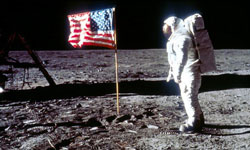5 Tiny Countries With Big Space Dreams

Ah, but a man’s reach should exceed his grasp, / Or what’s a heaven for?
— Robert Browning, from the poem “Andrea Del Sarto”
You don’t have to be a global giant to reach for the stars or to benefit from the pecuniary promise of space-age technologies. Thanks to the growing availability of public and private launch vehicles, “off-the-shelf” tech for kitting out satellites and serious opportunities for research collaboration, even the smallest nations on Earth can dream big.
Sure, these Lilliputian lands might not plant a flag on the moon, but their Brobdingnagian ambitions are no less symbolically or economically important to their people. For countries of a few million persons inhabiting a couple hundred square miles of land, designing a new sensor for another country’s satellite or sending astronauts to the International Space Station are all monumental undertakings.
As you’ll see in this article, if you’re a mighty mite with a big space dream, it helps to have a strong economy, some able associates and solid trade partners. A hi-tech background doesn’t hurt either.
For 20 years after Lithuania became the first Soviet republic to declare its independence on March 11, 1990, the Baltic country lacked direct access to space. Despite a struggling economy, the 25,212-square-mile (65,300-square-kilometer) parliamentary democracy, slightly larger than West Virginia, has been working to reclaim its place in space ever since.
The intellectual genealogy of this country of 3.5 million reaches back centuries, to the pioneering work in rocketry, astronomy and aeronautics of Kazimieras Simonavičius, Vilnius University and Aleksandras Griškevičius, respectively.
Lithuania contributed much to the Soviet space program, donating scientists to the Mars and Venera projects and cosmonauts to the Soyuz and Soviet space shuttle programs. Lithuanian institutions studied plant physiology under zero gravity conditions on the Salyut and Mir orbital stations, developed robotic vision for the Lunokhod lunar rover, designed heat insulation panels for the shuttle Buran and researched control systems for liquid-fueled rocket engines.
Since then, Lithuania has contributed to numerous NATO and European R&D programs, and has entered into a cooperation agreement with the European Space Agency. More than 100 scientists and engineers of Lithuanian origin have contributed to NASA programs such as Cassini, Galileo, Mariner, Pioneer, Venus and Voyager [source: Lithuanian Space Association]. At home, Lithuanian space research focuses primarily on microsensors and micro-actuators, thermo-aerodynamics, microgravity, astrophysics, and information and communications technology.
As of April 2011, representatives of Vilnius Gediminas Technical University and the Lithuanian Space Association were shopping around the idea of developing a small satellite to carry a scientific payload into orbit and return it to Earth for retrieval.
Now let’s roll into a Low Country with high hopes in space.
Belgium has more going for it than beer, chocolate and waffles; it’s also been in the space biz since the 1960s. Rather than establish its own space agency, this modern, technologically advanced Low Country of 10.4 million integrated itself from the get-go into European space ambitions.
The land of Dutch-speaking Flemings and French-speaking Walloons — occupying 11,787 square miles (30,528 square kilometers, roughly the size of Maryland) in Europe — helped bring about the European Space Agency (ESA). It continues to build bilateral agreements with the continent’s other space agencies and has remotely conducted experiments aboard the American space shuttle.
As of January 2012, more than 40 Belgian enterprises, employing around 1,300 people, were engaged in space-related development, and 36 technical groups were working on 75 Belgian projects of PRODEX ((PROgramme de Développement d’Expériences scientifiques, or Development Program for Scientific Experiments), an ESA project that coordinates experimental development and industrial contracts [source: BELSPO].
Belgium hosts a bunch of ESA testing, calibration and inspection facilities: The Liège Space Centre provides testing under vacuum conditions; the von Karman Institute investigates atmosphere re-entry for spacecraft and the Cyclotron Research Centre explores how cosmic radiation affects electronic components.
The ESA’s first small satellite, a collaborative effort called PROBA (Project for On-Board Autonomy), was built in Belgium. Designed for a one-year mission, the shoebox-sized craft, which monitors high-energy charged particles, celebrated its 10th operational anniversary on Oct. 22, 2011.
Next up: a tiny country that has not only built satellites, but has also launched them using its own rockets.
A nation of few natural resources, Israel has long relied on high technology exports such as aviation, communications and fiber optics to help drive its economy. Perhaps that’s why this Middle Eastern nation of 8,019 square miles (20,770 square kilometers, roughly the size of New Jersey) leads the pack in the race to the stars by not only operating satellites, but also launching them into space aboard homegrown rockets.
On Sept. 19, 1988, the parliamentary democracy of 7.5 million propelled its first satellite, Ofeq-1, into orbit using an Israeli Shavit three-stage launch vehicle, distinguishing it as the eighth country in the world to achieve such a feat. Israel’s technological advances, particularly in miniaturization, helped to make its rocket and satellite programs possible.
In 2003, the first Israeli astronaut, Ilan Ramon, joined the space shuttle Columbia as its payload specialist. Sadly, his first flight was to be his last, as that was the fateful flight that saw the shuttle break up over Texas.
Israel has emerged as a player in commercial space, and the Israel Space Agency has collaborated with NASA, France and Germany in several ventures. The country has also recognized the value of space-based research, such as medical studies in microgravity and space-based crystal growth.
In July 2010, Israel announced that it would stake $77.5 million over five years to spur a civilian space program, projecting that it could seize 5 percent of the market and grow into a $10 billion civilian space industry [source: UPI].
For our next little giant, we’ll travel to the Gibraltar of the north.



 Creators of mankind
Creators of mankind Description of “Tall white aliens”
Description of “Tall white aliens” Where they came from?
Where they came from? About hostile civilizations
About hostile civilizations The war for the Earth
The war for the Earth “Tall white aliens” about eternal life
“Tall white aliens” about eternal life Video: “Nordic aliens”
Video: “Nordic aliens” Aliens
Aliens Alien encounters
Alien encounters The aliens base
The aliens base UFO
UFO Technology UFO
Technology UFO Underground civilization
Underground civilization Ancient alien artifacts
Ancient alien artifacts Military and UFO
Military and UFO Mysteries and hypotheses
Mysteries and hypotheses Scientific facts
Scientific facts


















